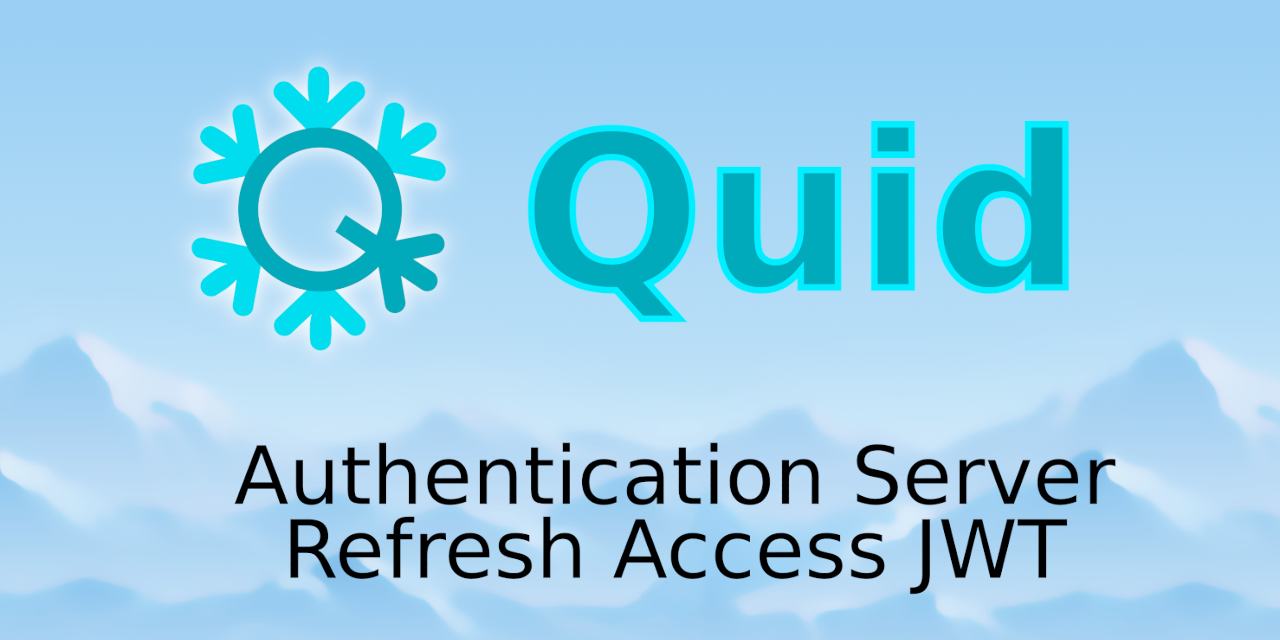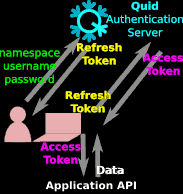 Quid
Quid 

Quid is a JWT server (frontend + backend + client libraries) to manage Administrators, Users, Refresh Tokens and Access Tokens in independent Namespaces providing signature verification for the following algorithms:
- HS256 = HMAC using SHA-256
- HS384 = HMAC using SHA-384
- HS512 = HMAC using SHA-512
- RS256 = RSASSA-PKCS1-v1_5 using 2048-bits RSA key and SHA-256
- RS384 = RSASSA-PKCS1-v1_5 using 2048-bits RSA key and SHA-384
- RS512 = RSASSA-PKCS1-v1_5 using 2048-bits RSA key and SHA-512
- ES256 = ECDSA using P-256 and SHA-256
- ES384 = ECDSA using P-384 and SHA-384
- ES512 = ECDSA using P-521 and SHA-512
- EdDSA = Ed25519
-
First, the user logs in with Namespace + Username + Password. The Namespace is usually the final application name, represented by Application API at the bottom of the previous diagram.
-
Then, the client (e.g. JS code) receives a Refresh Token that is usually valid for a few hours to avoid to log again during the working session.
-
The client sends this Refresh Token to get an Access Token that is valid for a short time, usually a few minutes, say 10 minutes. So the client must refresh its Access Token every 10 minutes.
-
During these 10 minutes, the client can request the Application API with the same Access Token.
-
When the Application API receives a request from the client, it checks the JWT signature and expiration time. The Access Token is stateless: the Application API does not need to store any information about the user (the Access Token content is enough).
Install
Download the latest release to run a binary or clone the repository to compile from source. See also the Dockerfile to run Quid within a light container (less than 20 MB).
Build from source
make all -j
Configure
-
Create the default config file:
./quid -conf -
Create the
quiddatabase: instructions -
Edit the configuration file to set your PostgreSQL credentials:
vim config.json -
Initialize the
quiddatabase and create the administrator user:./quid -initThese registered administrator username and password will be required to login the Administration UI.
Run the backend
./quid
or simply:
go run ./cmd/quid -dev
See also: run in dev mode
Quid serves the static web site. Open http://localhost:8082 to login into the admin interface:
xdg-open http://localhost:8082
Deploy on Heroku
Request tokens
Request a refresh token and use it to request access tokens.
Refresh token
A public endpoint is available to request refresh tokens for namespaces. A time to live must be provided.
Example: request a refresh token with a 10 minutes lifetime /token/refresh/10m
curl localhost:8082/token/refresh/10m \
-H 'Content-Type: application/json' \
-d '{"namespace":"my_namespace","username":"my_username","password":"my_password"}'Response:
{ "token": "eyJhbGciOiJIUzI1NiIsInR5cCI6IzpXVCJ9..." }Access token
A public endpoint is available to request access tokens for namespaces. A time to live must be provided.
Example: request an access token with a 10 minutes lifetime /token/access/10m
curl localhost:8082/token/access/10m \
-H 'Content-Type: application/json' \
-d '{"namespace":"my_namespace","refresh_token":"zpXVCJ9..."}'Response:
{ "token": "eyJhbGciOiJIUzI1NiIsInR5cCI6IzpXVCJ9..." }Note: if the requested duration exceeds the max authorized tokens time to live for the namespace the demand will be rejected
Decode tokens
Python
import jwt
try:
payload = jwt.decode(token, key, algorithms=['HS256'])
except jwt.ExpiredSignatureError:
# ...Payload example:
{
"usr": "jane",
"grp": ["group1", "group2"],
"org": ["organization1", "organization2"],
"exp": 1595950745
}Note: "exp" is the expiration timestamp in Unix time format (seconds since 1970).
Examples
See the examples for various backends.
Client libraries
Client libraries transparently manage the requests to api servers. If a server returns a 401 Unauthorized response when an access token is expired, the client library will request a new access token from a Quid server, using a refresh token, and will retry the request with the new access token.
Javascript
QuidJS : the javascript requests library.
WebAuthn and FIDO2 features
Quid does not support WebAuthn and FIDO2. See the following open-source projects providing these features:
-
Authelia https://github.com/authelia/authelia
Authentication server with 2FA/SSO/OTP/FIDO2 already supported by Traefik, Nginx, HAProxy, Caddy -
Kratos https://github.com/ory/kratos
Identity server in Go: MFA, FIDO2, social sign in, password-less, registration, account recovery… -
WebAuthn https://github.com/duo-labs/webauthn
WebAuthn/FIDO2 server library in Go (the Python version is more active) -
WebAuthn Demo https://github.com/fido-alliance/webauthn-demo
WebAuthn demo in HTML and JavaScript -
Portier (see the reference implementation in Rust)
Password-less login server using email/OpenID/OAuth2/JWT, successor to Persona (Portier is simpler than Persona)
Other Go and JWT related projects:
-
Other Authentication tools in Go:
https://github.com/avelino/awesome-go#authentication-and-oauth


